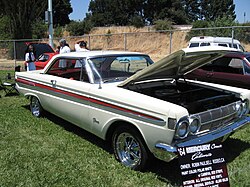Mercury Caliente
| Mercury | |
|---|---|
|
Mercury Caliente (1964)
|
|
| Caliente | |
| Production period: | 1964-1967 |
| Class : | Middle class |
| Body versions : | Sedan , coupe , convertible |
| Engines: |
Petrol engines : 2.7-3.2 liters (74-88 kW) |
| Length: | 4955-5169 mm |
| Width: | |
| Height: | |
| Wheelbase : | |
| Empty weight : | 1073-1436 kg |
| successor | Montego |
The Mercury Caliente was a passenger car manufactured by Mercury , a brand of the Ford Motor Company , from 1964 to 1967 . It was the most luxurious version of the small Mercury Comet .
Like the Comet, the Caliente was also based on various contemporary American Ford models. Base of the Comet was from
- 1964 to 1965 the Ford Falcon
- 1966 to 1967 the Ford Fairlane .
The Falcon-based Caliente (1964–1965)
Compared to the normal Comet, the Caliente had better features, e.g. B. a padded dashboard with walnut inlay and thicker carpets. In addition to the four-door sedans, there was a hardtop coupe and a convertible. With the Comet, the Caliente also shared the drive: an overhead six-cylinder in-line engine with 2734 cm³ displacement, the 101 bhp (74 kW) at 4400 rpm. submitted.
In 1965 the Caliente had instead of the side by side double headlights arranged one above the other. In addition, like the Comet, there was a larger engine with 3217 cm³ displacement and 120 bhp (88 kW) power at 4400 rpm. The convertible got an electrically operated roof.
123,080 copies of the first Caliente series were produced.
The Fairlane-based Caliente (1966–1967)
The Comet models from 1966 were no longer based on the Ford Falcon , but on the larger Ford Fairlane . The wheelbase increased by 2 "(51 mm). The drive and appearance of the car, however, remained the same, as did the range of body versions.
There were no major changes in 1967 either. The Caliente remained the best execution of the Mercury Comet .
The second series produced 69,375 copies. In 1968 the Caliente was replaced by the Mercury Montego .
source
Gunnell, John: Standard Catalog of American Cars 1946-1975 . Krause Publications, Iola 2002. ISBN 0-87349-461-X
